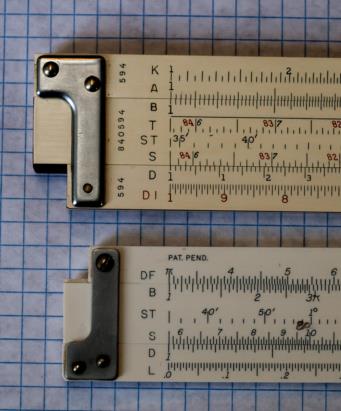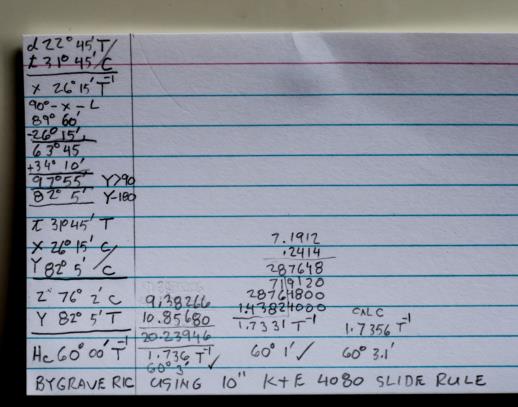
NavList:
A Community Devoted to the Preservation and Practice of Celestial Navigation and Other Methods of Traditional Wayfinding
Re: Bygrave formula accuracy on 10 inch slide rule
From: Greg Rudzinski
Date: 2015 Jul 7, 17:55 -0700
From: Greg Rudzinski
Date: 2015 Jul 7, 17:55 -0700
Paul,
I had very good luck with your slide rule method for tangents > 45° using a K&E 4080-3 and 4070-3. Six reductions will now fit on the RIC index card. Bygrave with 10" slide rule is back in the micro kit for now.
Greg Rudzinski
From: Greg Rudzinski
Date: 2015 Jul 7, 13:02 -0700Paul,
The wrinkle that you discuss is where I had trouble. I will try the co-tan method as you have discribed.
Steps 6 and 7 are a wrinkle which relies on the fact that when a number on D is at the C index, its reciprocal is on C at the D index. For instance, set a C index to 2 on D and observe .5 on C at a D index. In this case, step 5 leaves a tangent (about 4.0) on D at the C index (or S index on my rule). Its arc tangent is beyond the range the T scale. However, if we convert the tangent to a cotangent, arc cot may be obtained from the red numbers on T. Steps 6 and 7 elegantly accomplish that.
On the pocket 6" K&E Doric slide rule there is no DI scale. I had to use the CI scale on the back side which is bad news for the Bygrave formula :( The 10" K&E will be needed.
Greg Rudzinski
From: Paul Hirose
Date: 2015 Jul 06, 23:22 -0700
On 2015-07-06 9:51, Greg Rudzinski wrote: > The pocket 6" slide rule struggled through the Bygrave formula (see attached RIC example). Tangents over 45° are not handled well on the standard slide rule :( There's no description of the slide rule manipulations, so it's not clear where the struggle occurred. And I don't agree that "Tangents over 45° are not handled well on the standard slide rule." To the contrary, I'll show that they eliminate two moves in the solution of Greg's example. Often I will mention the S index. That's because the rule I used, the K&E 4181-3, has no C scale on its "trig" side. Instead, the S scale is at the bottom of the slide, where more fully equipped rules have a C scale. The seemingly cheap arrangement is only an occasional inconvenience, and none at all in this example. Input data are lat = 34.17, dec = 22.75, t = 31.75. First solve for x: x = arctan(tan dec / cos t) = arctan(tan 22.75 / cos 31.75) = 26.25 Solution: 1) match indices (i.e., put corresponding graduations on the slide and body into coincidence), 2) hairline to 22.75 on T, 3) red 31.75 on S to hairline, 4) hairline to right S index, 5) match indices, 6) read 26.25 on T at hairline. Calculate Y from latitude and x: 90.00 -34.17 = lat +26.25 = x ------ 82.08 = Y Calculate azimuth = arctan(tan t * cos x / cos Y) = arctan(tan 31.75 * cos 26.25 / cos 82.08) = 76.03 To solve that equation, 1) match indices, 2) hairline to 31.75 on T, 3) right index of S to hairline, 4) hairline to red 26.25 on S, 5) red 82.08 on S to hairline, 6) hairline to right D index, 7) read red 76.03 on T. Steps 6 and 7 are a wrinkle which relies on the fact that when a number on D is at the C index, its reciprocal is on C at the D index. For instance, set a C index to 2 on D and observe .5 on C at a D index. In this case, step 5 leaves a tangent (about 4.0) on D at the C index (or S index on my rule). Its arc tangent is beyond the range the T scale. However, if we convert the tangent to a cotangent, arc cot may be obtained from the red numbers on T. Steps 6 and 7 elegantly accomplish that. Note that if azimuth were less than 45°, the final steps would be 6) hairline to S index, 7) match indices, 8) read azimuth at hairline on T. That's one additional move! Finally, compute Hc = Atan(cos az * tan Y) = arctan(cos 76.03 * tan 82.08) = 60.05. The procedure is: 1) match indices, 2) hairline to red 76.03 on S, 3) red 82.08 on T to hairline, 4) hairline to D index, 5) read red 60.05 on T. Again the apparent difficulties are easily dodged. First is the multiplication by tan 82.08, which is beyond the T scale range. Instead, use the red numbers on T to divide by the cotangent. The quotient, about 1.7, is the tangent of Hc. Its arctan is not directly readable, but the wrinkle utilized in the azimuth formula works again. Note that if all angles were less than 45°, the steps would be 1) match indices, 2) hairline to red 76.03 on S, 3) S index to hairline, 4) hairline to Y on T, 5) match indices, 6) read azimuth at hairline on T. That's an additional move. A few slide rules have a double T scale. One scale is like the traditional single T. The other extends the range to tangents from 1 to 10. It doesn't do anything you can't do with a single T. However, it's more convenient if you're uncomfortable with the techniques I demonstrated above. But even a double T scale won't help with x = arctan 15. In slide rule trig you eventually run into something like that, and then you're shipwrecked unless you know the main identities. In this case, (90 - x) = arctan(1/15). Use the small angle scale ST for the arctan. It's a far cry from pushing buttons on a calculator!








